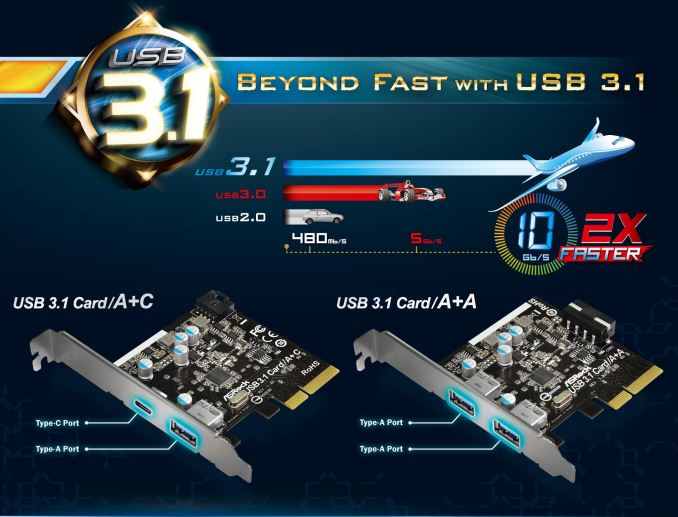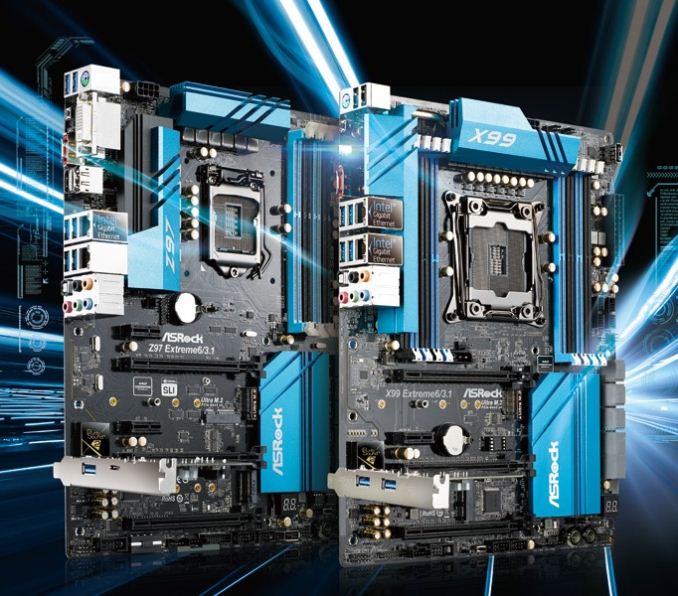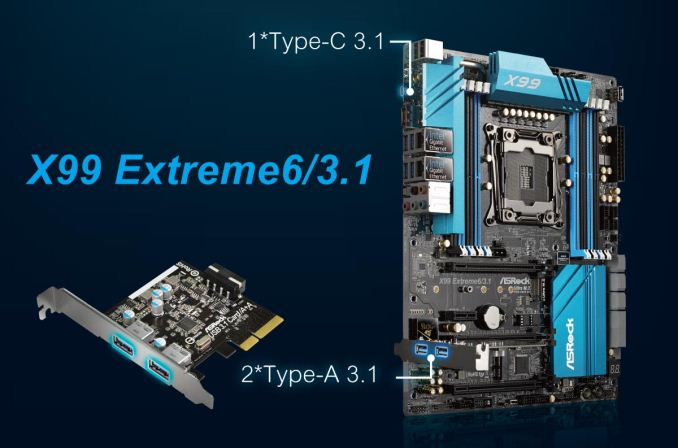ASRock to Introduce USB 3.1 Cards and Motherboards
by Ian Cutress on February 16, 2015 7:35 AM EST
On the back of our USB 3.1 performance coverage, as well as seeing some motherboards in the flesh at CES, other manufacturers are now announcing their USB 3.1 implementations. ASRock distributed a press release today confirming that they will be launching a couple of interesting USB 3.1 devices. Up first are the USB 3.1 PCIe cards, capable of either two Type-A ports or a combination of Type-A and Type-C.
These cards look to be PCIe 2.0 x2 cards, giving the 10 Gbps needed to saturate a USB 3.1 port. It is worth noting then that the combined throughput of two ports on one card will be 10 Gbps, rather than 10 Gbps on each. Interestingly each card seems to have a power requirement – on the dual Type-A card there is a 4-pin molex whereas on the combo card there is a 4-pin custom/floppy sized connector. The power connectors on each card allow each port to provide up to 3 amps at 5V, giving 15W charging a possibility. (Unfortunately dreams of 100W charging are still in the air at the moment, as it requires a power delivery design to step up 12V to 20V at 5A, as well as providing a 100W source though a power connector.)
ASRock will be providing these cards as bundles in two models – the Z97 Extreme6/3.1 and the X99 Extreme6/3.1. The Z97 model will come with the combination A+C card whereas the X99 will come with two Type-A because the board will already come with a Type-C onboard.
This means that the X99 Extreme6/3.1, with the PCIe card installed, should be capable of three USB 3.1 devices being attached. All we have to wait for now is USB 3.1 devices to actually come to market. In that respect it might be worth considering that buying these now will require waiting for the rest of the industry to catch up.
ASRock did not distribute any pricing or launch window information as this was a global press release, but I would imagine within the next month to see something on the shelves. I have had a Skype message offering a board for review, so they must be near-final.















53 Comments
View All Comments
Christopher1 - Monday, February 16, 2015 - link
I've pretty much phased out all my USB 2.0 devices, save for my laptop computer's XBox 360 controller receiver and my mouse. I got a new USB 3.0 USB 32GB flash drive to replace my USB 2.0 16GB flash drive and trashed the older drive after breaking it into so many pieces, data recovery was going to be impossible.Yes, I am a bit paranoid, especially since the drive in question had my passwords and usernames for websites as a backup on it.
SleepyFE - Monday, February 16, 2015 - link
Unification. No need for type A or B. Type C covers usage scenario.A5 - Monday, February 16, 2015 - link
Increased port density + reversible is pretty nice. I'd imagine you'd be able to get 10+ Type-C ports in the back panel space currently used by the 6 Type-A ports.Or a case where some of the FP connectors are Type-C, so you can have more than 2 easily accessible.
Flunk - Monday, February 16, 2015 - link
Same reason why we need to ditch the full-size displayport port. There is no reason at all to have a separate smaller connector for notebooks/smart devices. It will be a while but hopefully we'll ditch even more legacy ports with the type C connector.Kevin G - Monday, February 16, 2015 - link
Full sized DP has a good locking connector. There are a few use-cases were this matters (AV rack installation etc.) so that they don't become lose over time due to vibration. I see this hanging around for awhile on monitors and professional AV equipment.For consumers, I can see Mini-DP taking over entirely. Ideally with USB 3.1 Type-C alternate modes, even Mini-DP can be phased out.
eddman - Monday, February 16, 2015 - link
I failed to mention my point. I mean that given type-C's very small and thin form factor, wouldn't it be better to keep the full-size, more robust type-A at the back of desktop computers? Some cables could be rather heavy and in the long run, C might wear out sooner.Type-C on the front is a good idea though.
I'm kind of not comfortable with having only type-C on laptops too. Imagine a type-C flash drive or a data modem is connected. Put a bit too much force on it by accident and it might turn out ugly.
2 type-As plus a type-C would be a ok combination though.
This is all speculation of course. Have to wait and see if C can be as robust as A.
Murloc - Monday, February 16, 2015 - link
it's gonna be wider than micro usb so it should be good enough although clearly not as robust as A, but robustness isn't really the priority here I think, but rather sticking more than just one port on a laptop.People smash their smartphone screens all the time and that hasn't done anything to stop the trend either.
alkarnur - Monday, February 16, 2015 - link
Type-C is more useful for mobile applications given its compactness and the significant speed upgrade over micro USB 2.0 dominant among smartphones and tablets today. Additionally it will allow for even thinner laptops and ultrabooks.As for the desktop, its main advantage is its reversibility.
USB 3.1 speeds are actually ahead of the storage technology as HDDs weren't bottlenecked by USB 3.0 anyway and aren't increasing in speed for that to ever an issue.
As for SSDs, they would see a speed increase from USB 3.1, assuming on both ends of the transfer there's fast enough SSDs to take advantage of it.
However, the reason I say USB 3.1 is ahead of storage technologies is that the price per terabyte for SSDs is still high. The speed benefit for SSDs at USB 3.1 over USB 3.0 will only translate into significant and worthwhile amounts of time saved when you're transferring several terabytes from one SSD to another. And multi-TB SSDs are still not that available and, if available, not even close to affordable.
tyger11 - Monday, February 16, 2015 - link
The back of the case is THE best scenario to justify a Type-C connector - when you can't see the orientation of it.CharonPDX - Monday, February 16, 2015 - link
Because it's the new standard.Because when you can't see behind the computer, having a reversible connector is good.
Personally, I'd prefer to see *ALL* USB 3.1 implementations use *ONLY* the type-C connector. Get the old connector mess out of the way as quickly as possible. Just ship it with a couple C-to-A adapters or C-to-B cables.